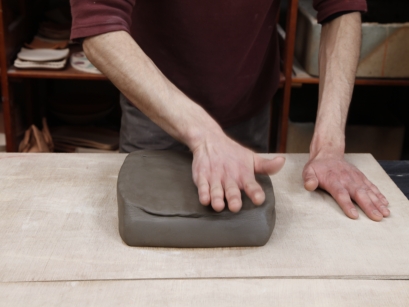Macha Tea cups.jpg)
(Powdered Japanese Green tea) |
Long plates.jpg)
|
| Electric wheel |
Hand wheel |
Slab builting |
.jpg) |
.jpg) |
 |
|
|
Technique Used: Electric wheel
Each participant will use the electric wheel and the so called Baibiki
technique
to create traditional Japanese tea cups. The technique used, will allow
the participant to have full control of the lips and the overall shape
of the cup and to be able to visualize the scenery or the "Keshiki"
as it is called in Japanese which is a neccessary ingredient when creating
Japanese tea cups. |
Technique Used: Hand building
Each participant will use a hand steered wheel and the so called Himozukuri
(coil building) technique in order to create a Japanese tea cup. Similarly
to the clectric wheel, the hand wheel allows the participant to have a
high degree of control in the lip and the overall shape of the cup. This
way the participant can concentrate on visualizing the scenery which is
a necessary ingredient when creating Japanese tea cups. |
Technique Used: Slab Building
Each participant through the process of Slab Building, or the Itazukuri
technique, will create a traditional Japanese board-shaped platter. Stone
decoration techniques and Oribe's unique iron painting techniques will
allow each participant to decorate his/her creation while experiencing
Japan's traditional sense of Balance. |
Duration: 60 min (approximately)
Produced Artifacts:Japanese Macha Tea Cups (there's a choice between 3
or 4 types of cups)
Production Process:
・Shaping (done individually)
・Trimming (Saideigama staff)*
・Biscuit firing (Saideigama staff)
・Decorating and glazing (Saideigama staff)*
・Final firing (Saideigama staff)
Participation Fee:¥5.500
*this part of the process can be done by the participant yourself with an
extra chage of ¥3.500. |
Duration: 60 min (approximately)
Produced Artifacts:one Japanese tea bowl
Production Process:
・Shaping (done individually)
・Trimming (Saideigama staff)*
・Biscuit firing (Saideigama staff)
・Decorating and glazing (Saideigama staff)*
・Final firing (Saideigama staff)
Participation Fee:¥3.500
*this part of the process can be done by the participant yourself with an
extra chage of ¥3.500. |
Duration: 60 min (approximately)
Produced Artifacts:one Japanese long plate
Production Process:
・Shaping (done individually)
・Decoration: (done individually)
・Decorating and glazing (Saideigama staff)
・Glazing (Saideigama staff)*
・Final firing (Saideigama staff)
Participation Fee:¥5.000
*this part of the process can be done by the participant yourself with an
extra chage of ¥3.500. |
| the number of participants is limited to 14 people in each session. |
the number of participants is limited to 20 people in each session. |
the number of participants is limited to 20 people in each session. |